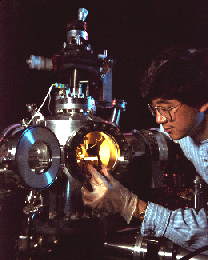Research in the
National Interest
 Harnessing innovative research at the frontiers of
science is a key to global competitiveness and economic prosperity for the
nation. With its multidisciplinary focus, LBL is an important player in a
variety of those scientific frontiers, such as biotechnology, materials
science, and environmental technology.
Harnessing innovative research at the frontiers of
science is a key to global competitiveness and economic prosperity for the
nation. With its multidisciplinary focus, LBL is an important player in a
variety of those scientific frontiers, such as biotechnology, materials
science, and environmental technology.
In the past three years, technology transfer efforts have helped secure 80
partnerships between LBL and industry.
The crown jewels of the partnership effort are the Energy
Research Laboratory Technology Transfer (ER-LTT) awards, a type of Cooperative
Research and Development Agreement funded by the Office of Energy Research. The
following are a few of the collaborations that have been forged through the
ER-LTT program.
DIABETES AND OBESITY
A $1.5 million ER-LTT partnership that uses technology
from LBL's Human Genome Center may yield tools to tackle two widespread human
health problems. LBL has paired with pharmaceutical giant Rhone Poulenc-Rorer
Inc. to clone genes involved in diabetes and obesity.
Eddy Rubin of LBL's Life Sciences Division will attempt to pinpoint genes thought to be
related to the disorders in genetically engineered mice. The two types of mice
have been specially bred over many generations to display symptoms
characteristic of human diabetes and obesity. The defective genes thought to be
the cause of the symptoms have been mapped to regions on mouse chromosomes 4
and 6.
Rubin will attempt to cure the ailments in the diabetic and
obese mice with healthy genes taken from chromosomes 4 and 6 in mice without
the diseases.
Rhone Poulenc-Rorer will use the protein products from the
genes to develop drugs to treat diabetes and obesity in humans.
FLAT-PANEL DISPLAYS

Researcher Tony Chen prepares to test prototype cathode material in a
field emission test apparatus. LBL is collaborating with SI Diamond, Inc. to
develop cathode materials for use in flat-panel displays.
Computer screens that are credit card thin and use less
energy are the goal of a $1 million partnership between LBL and SI Diamond,
Inc. LBL's Joel Ager and a team of Materials Sciences Division investigators
will help the Houston, Texas firm better understand the unique,
electron-emitting material that is the basis for its flat panel computer
displays.
The flat panel display market is expected to grow from $5
billion to $20 billion by the end of the decade. While the United States
currently has only 5% of the flat panel display market, it has an important
technological head start on market leaders such as Japan on flat-panel
technology that uses "cold" cathodes. Such energy-efficient cathodes will play
an important role in creating the next generation of low-power flat panel
displays.
Conventional desktop displays are lit by a cathode-ray
electron gun that from a distance scans an electron beam across a grid of
phosphor elements many times a second. The flat panel technology being
developed by SI Diamond replaces the single electron gun with an array of
thousands of tiny electron sources much closer to the phosphor grid. The
electron sources are known as cold cathodes because they emit electrons at much
lower temperatures--and thus use a third as much energy--than conventional
electron sources.
The partnership will work to understand the physical
properties of a material called amorphous diamond, which is the basis for SI
Diamond's special cathodes. Scientists will study ways to create the large,
homogenous surfaces of amorphous diamond required for large displays.
The project will take advantage of a wide range of capabilities available at
LBL, such as atomic force, scanning tunnelling, and electron microscopies,
imaging Raman spectroscopy, and advanced electronic characterization.
PARKINSON'S DISEASE

A PET scan image shows chemical uptake in the brain of a
monkey to test the effectiveness of a treatment for Parkinson's disease. The
work is part of an LBL collaboration with Somatix Therapy Corporation.
LBL is putting its medical imaging technology to work in
the fight against Parkinson's disease with a $2.5 million partnership with
Somatix Therapy Corp. of Alameda, Calif. The collaboration will test a method
for restoring levels of important brain chemicals in animals, with hopes of
eventually developing a similar treatment for human Parkinson's patients.
Parkinson's afflicts almost a million people in the United States.
Somatix will use genetic engineering to create fibroblast skin cells that
produce the neurochemical dopamine, which is depleted in patients with
Parkinson's. The altered cells will be implanted in brains of animals with the
disease.
William Jagust of the Life Sciences Division's Center for
Functional Imaging at LBL will use scanning techniques to study to what extent
dopamine levels are restored by the fibroblasts. Positron emission tomography
(PET) and single photon computed tomography (SPECT) scans will detect
radiolabelled compounds injected into the animals that are specifically taken
up by dopamine-producing cells.
Somatix plans to develop a way to insert
genes into human cells that allows them to produce specific chemicals. Such
cells could similarly be implanted in the brains of patients to restore
deficiencies related to brain diseases such as Parkinson's and possibly
Alzheimer's.
-- Mike Wooldridge
 Return to Highlights Table of Contents
Return to Highlights Table of Contents
 Harnessing innovative research at the frontiers of
science is a key to global competitiveness and economic prosperity for the
nation. With its multidisciplinary focus, LBL is an important player in a
variety of those scientific frontiers, such as biotechnology, materials
science, and environmental technology.
Harnessing innovative research at the frontiers of
science is a key to global competitiveness and economic prosperity for the
nation. With its multidisciplinary focus, LBL is an important player in a
variety of those scientific frontiers, such as biotechnology, materials
science, and environmental technology. 

 Return to Highlights Table of Contents
Return to Highlights Table of Contents